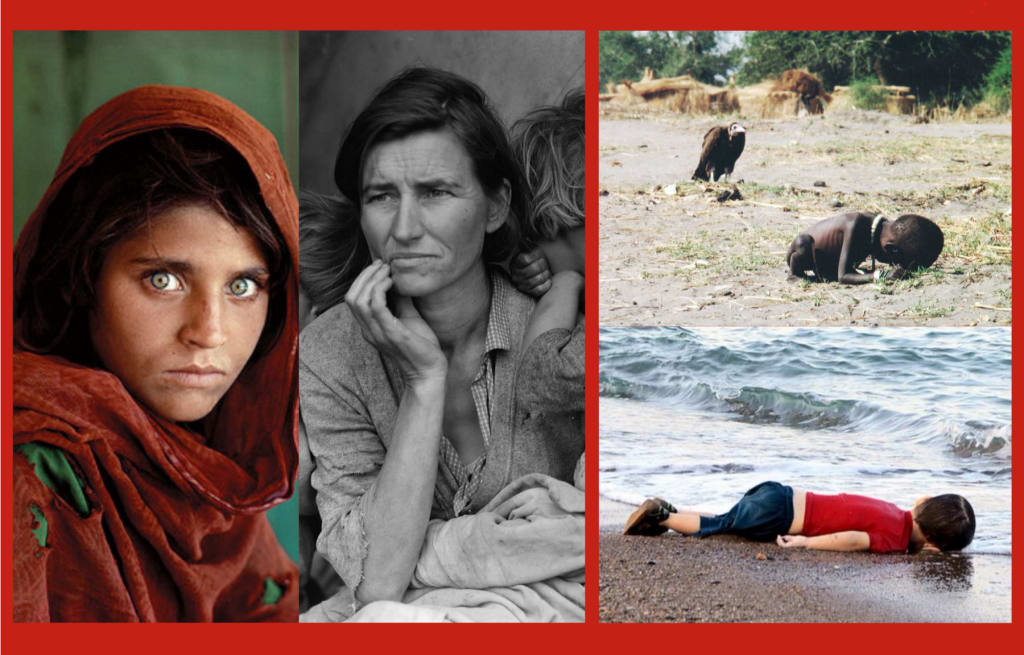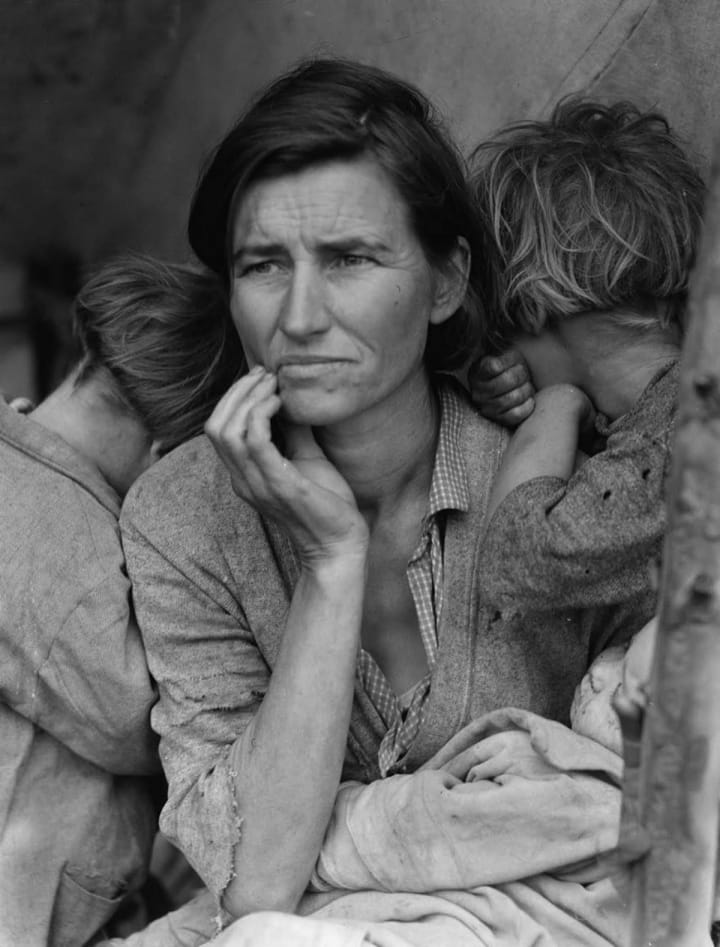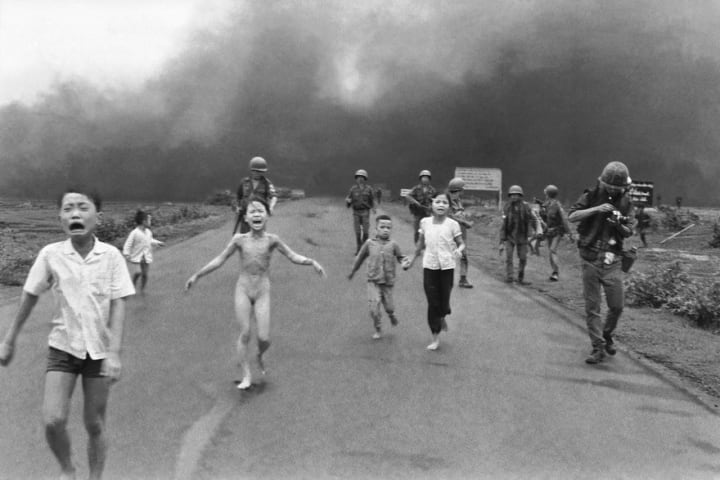The Troubling True Story Behind Famous Photos
Is a picture worth a thousand words?

Do you know the true story behind these famous photos?
Starving Child And Vulture

In 1993, Kevin Carter, a South African photojournalist, traveled with a friend to shoot the Sudanese rebel movement amid a famine. Carter began photographing starving victims as soon as their jet touched down in the town of Ayod.
However, Carter soon became overwhelmed and escaped into the woods to get away from the sight of multitudes of people starving to death.
While in the woods, Carter heard a quiet, high-pitched whimper and observed a boy, initially misidentified as a girl, who had stopped to rest on his way to a UN feeding center half a mile away. A vulture soon landed nearby the emancipated child.
Carter then positioned himself for the best possible image, taking care not to disturb the bird. He claimed to have waited roughly 20 minutes, hoping that the vulture would open its wings. It didn't, so he chased the bird away after taking his photos and stood there watching the little child struggle again.
He didn't know it, but Kevin Carter had just captured one of the most iconic and controversial photos of all time. For, unlike earlier photos of starving children with "flies in their eyes," this one focused on the plight of a vulnerable famine victim crawling to food.
The photograph was sold to The New York Times and published for the first time on March 26, 1993. Hundreds of people contacted the newspaper immediately to inquire about the child's survival, prompting the publication to publish a special editor's note stating that the child had enough strength to walk away from the vulture but that the child's ultimate destiny was unknown.
Though the photograph drew widespread attention to the humanitarian situation engulfing Sudan, it was panned by others who said Carter should have aided the girl instead of profiting from her suffering. In venomous hate letters, they claimed that Carter was the actual vulture.
"The man adjusting his lens to take just the right frame of her suffering, might just as well be a predator, another vulture on the scene". - The St. Petersburg Times (Florida).
Carter would earn a Pulitzer Prize for the photo in April 1994, but the prestige did not diminish his mental anguish. According to a friend and colleague, he was despondent and kept repeating he wanted to embrace his small daughter. Carter frequently expressed sorrow for not doing more to assist the girl, even though there was nothing he could have done in reality, having been operating when photojournalists were forbidden from touching hunger victims for fear of spreading disease.
Carter served as a heartbreaking illustration of the psychological toll photojournalist. He later committed suicide on July 27, 1994, just three months after collecting the Pulitzer Prize. He was only 33 years old.
Migrant Mother

It's one of America's most recognizable images.
A mother in shabby attire holds a newborn. Her two young children cuddle her, covering their faces behind her shoulders. With one hand raised to her mouth and anxiousness carved deep in the creases on her face, the mother squints into the distance.
The photograph known as "Migrant Mother" came to symbolize the hunger, poverty, and hopelessness experienced by so many Americans during the Great Depression.
Dorothea Lange shot this iconic black-and-white photograph in 1936 while working for the Resettlement Administration, which eventually became the Farm Security Administration (FSA). The agency was established during the Great Depression to raise awareness of impoverished farmers and provide relief.
Lange met Florence Owens Thompson and her children in a camp full of field workers whose livelihoods had been destroyed by the collapse of the pea crops in Nipomo, California. At that time, Thompson and her family subsisted on frozen vegetables from the field and the wild birds the children caught.
Soon after snapping the picture, Lange told a San Francisco newspaper editor about the field workers. The editor published an article with two of her photographs, compelling the federal government to deliver 20,000 pounds of much-needed food to the camp.
Decades later, Thompson was tracked down by Modesto Bee reporter Emmett Corrigan and she agreed to tell her story. As it turned out, Thompson did not profit from her role as "Migrant Mother." She continued to work hard to keep her family together while her image was being commodified.
"I didn't get anything out of it. I wish she hadn't taken my picture. … She didn't ask my name. She said she wouldn't sell the pictures. She said she'd send me a copy. She never did."
Thompson told the reporter she regarded Lange's photograph as a curse. During the interview, Thompson was embarrassed to bring up the poverty she had experienced decades before, but her children had a different opinion. They were proud of the woman who put her family first and became a symbol of female resilience through difficult times.
The Terror Of War

The day was June 8, 1972. Trang Bang, a village in South Vietnam, had recently been seized by the North Vietnamese Army (VNA). To avoid becoming casualties of war, several locals, including Phan Thi Kim Phuc and her family, had sought refuge in the village's Cao Dai Buddist temple. However, the last few days saw the battle draw closer and closer to the temple.
As a South Vietnamese soldier yelled for them to evacuate the temple, a roar could be heard overhead. Nine-year-old Phan Thi Kim Phuc twisted her neck to gaze upwards. A South Vietnamese pilot had mistaken the locals for enemy forces and soon blasted the area with napalm. Everyone fled.
In the meanwhile, Associated Press (AP) photographer, Huỳnh Công Út, known professionally as Nick Ut, was gathered on Highway 1 with other foreign journalists. From his vantage, Nick Ut witnessed a group of terrified children running from their village and captured the scene.
Phan Thi Kim Phuc, the small child in the foreground of the Pulitzer Prize-winning photo, was naked due to her cotton clothes having evaporated in contact with the napalm. Her arms thrust out in agony, her face contorted in a howl. "It's too hot! It's too hot!" she cried before collapsing.
Nick Ut grabbed the unconscious Phan Thi Kim Phuc from the ground and drove her to the hospital and then to an American care center, where her life was saved.
Despite having to undergo censorship battles to be published due to the young girl's nudity, the shot became one of many iconic images revealing the Vietnam war's atrocities. Richard Nixon, the president at the time, even attempted to suggest that the photograph was a forgery. Nick Ut replied, "The horror of the Vietnam war recorded by me did not have to be fixed."
A year later, the Vietnam war concluded.
Unfortunately, Phan Thi Kim Phuc's personal war did not end quite as quickly. She endured a decades-long physical, emotional and psychological road to recovery and suffered third-degree burns on 30% of her body. Worst, her identity was stripped from her. She was no longer Phan Thi Kim Phuc; she was the "napalm girl."
After I got burned, I had a dream. I really wanted to become a doctor. Then, I got into medical school but then, at that moment, the Vietnamese government rediscovered me. I was that little girl in a famous picture, right? So, many foreign journalists came to Vietnam, and they wanted to interview me. So, because of that reason, I was put out of my school to basically do publicity.
And that was a really low point in my life. I didn't have any freedom to do whatever I wanted.
For years Phan Thi Kim Phuc was understandably left bitter and enraged due to the napalm attack but would eventually find peace after converting to Christianity. Phan Thi Kim Phuc now lives in Toronto with her family and works to assist other children who have been affected by war around the world.
Nick Ut and Phan Thi Kim Phuc are good friends who communicate almost every week. She refers to him as Uncle Nick and considers him a member of her family.
Afghan Girl

Millions saw her face, but no one knew her name.
National Geographic commissioned Steve McCurry in 1984 to photograph refugee camps near the Afghanistan-Pakistan border. He visited 30 camps, documenting Afghani refugees, many of whom had fled the country owing to the turmoil caused by the Soviet invasion of Afghanistan in 1979.
"There were, in some cases, tens of thousands of Afghans pressed together in these squalid, really terrible conditions," McCurry said. "No plumbing, no electricity, and they'd have to carry water, there was disease - it was just a terrible existence."
One day, during his tour, McCurry heard the surprising sound of children's laughter emanating from inside a massive tent at one of those camps near Peshawar, Pakistan. Inside he discovered 15 young girls using the tent as a makeshift classroom.
"I noticed this one little girl with these incredible eyes, and I instantly knew that this was really the only picture I wanted to take."
The young girl initially covered her face with her hands. Understandable as McCurry was an outsider. A girl from her traditional Pashtun society would not disclose her face, share space, make eye contact, much less be photographed by a man who did not belong to her family. However, her teacher instructed Sharbat Gula to place her hands on her hips so that the rest of the world could see her face and learn about her story.
With sad, piercing green eyes, Gula set her sights on the camera. Wrapped in a torn maroon shawl, she had no idea her face would eventually be seen by millions of people the world over.
However, McCurry didn't write down Gula's name and instead labeled the photograph "Afghan Girl." Her face adorned the cover of National Geographic in June 1985.
For 18 years, Gula's identity was unknown to the world. Then, in January 2002, McCurry and National Geographic organized an expedition to find out if she was still alive. After months of searching, Gula was located in the Afghan-Pakistan border mountains. She was now a mother, hoping to provide her girls with the education she lacked. She had no idea that her image had come to symbolize the suffering of Afghan refugees in the ensuing years.
In her honor, National Geographic established the Afghan Girls Fund, a humanitarian organization dedicated to educating Afghan girls and young women.
Death of Alan Kurdi

It was the photo that brought the Syrian refugee situation to the attention of the entire world.
During the summer of 2015, Turkish press photographer Nilüfer Demir covered the European migrant crisis. On September 2, 2015, while photographing a group of Pakistani refugees along the Turkish coast, she came across Alan Kurdi's motionless body on the edge of Fener Burnu Beach.
Three-year-old Alan Kurdi and his family were attempting to cross the Mediterranean by boat after fleeing Kobani, a town in northern Syria that saw heavy combat between Islamic State insurgents and Kurdish forces.
Kurdi's family had chosen to pay people smugglers to transport them to the Greek island of Kos after Canada denied their refugee application. However, five minutes after leaving Turkey, their overcrowded rubber dinghy capsized.
Alan, his five-year-old brother Ghalib, and his mother Rehana died, leaving father Abdullah Kurdi as the family's only survivor.
The image of Alan's little, lifeless body washing up on Turkish shores sparked worldwide horror, pity, and anger. But it also served to bring the Syrian refugee situation to the entire world's attention, resulting in record donations to charities around the globe to help the victims.
About the Creator
Chelsea Rose
I never met a problem I couldn't make worst.






Comments
There are no comments for this story
Be the first to respond and start the conversation.